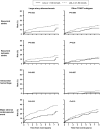Low-Density Lipoprotein Cholesterol and Risk of Recurrent Vascular Events in Chinese Patients With Ischemic Stroke With and Without Significant Atherosclerosis
- PMID: 34369170
- PMCID: PMC8475056
- DOI: 10.1161/JAHA.121.021855
Low-Density Lipoprotein Cholesterol and Risk of Recurrent Vascular Events in Chinese Patients With Ischemic Stroke With and Without Significant Atherosclerosis
Abstract
Background Recent trials have shown that low-density lipoprotein cholesterol (LDL-C) <1.80 mmol/L (<70 mg/dL) is associated with a reduced risk of major adverse cardiovascular events in White patients with ischemic stroke with atherosclerosis. However, it remains uncertain whether the findings can be generalized to Asian patients, or that similar LDL-C targets should be adopted in patients with stroke without significant atherosclerosis. Methods and Results We performed a prospective cohort study and recruited consecutive Chinese patients with ischemic stroke with magnetic resonance angiography of the intra- and cervicocranial arteries performed at the University of Hong Kong between 2008 and 2014. Serial postevent LDL-C measurements were obtained. Risk of major adverse cardiovascular events in patients with mean postevent LDL-C <1.80 versus ≥1.80 mmol/L, stratified by presence or absence of significant (≥50%) large-artery disease (LAD) and by ischemic stroke subtypes, were compared. Nine hundred four patients (mean age, 69±12 years; 60% men) were followed up for a mean 6.5±2.4 years (mean, 9±5 LDL-C readings per patient). Regardless of LAD status, patients with a mean postevent LDL-C <1.80 mmol/L were associated with a lower risk of major adverse cardiovascular events (with significant LAD: multivariable-adjusted subdistribution hazard ratio, 0.65; 95% CI, 0.42-0.99; without significant LAD: subdistribution hazard ratio, 0.53; 95% CI, 0.32-0.88) (both P<0.05). Similar findings were noted in patients with ischemic stroke attributable to large-artery atherosclerosis (subdistribution hazard ratio, 0.48; 95% CI, 0.28-0.84) and in patients with other ischemic stroke subtypes (subdistribution hazard ratio, 0.64; 95% CI, 0.43-0.95) (both P<0.05). Conclusions A mean LDL-C <1.80 mmol/L was associated with a lower risk of major adverse cardiovascular events in Chinese patients with ischemic stroke with and without significant LAD. Further randomized trials to determine the optimal LDL-C cutoff in stroke patients without significant atherosclerosis are warranted.
Keywords: ischemic stroke; low‐density lipoprotein cholesterol; prognosis; prospective cohort study.
Conflict of interest statement
Dr Lau reports grants, personal fees, and nonfinancial support from Boehringer Ingelheim; grants and nonfinancial support from Pfizer; grants from Amgen; grants from Eisai; grants and personal fees from Sanofi; and nonfinancial support from Daiichi Sankyo outside the submitted work. Dr Lau has also received funding from the Health and Medical Research Fund, Hong Kong Government Food & Health Bureau; Innovation and Technology Fund for Better Living, and University Grants Committee, Hong Kong outside the submitted work. The remaining authors have no disclosures to report.
Figures



References
-
- Kleindorfer DO, Towfighi A, Chaturvedi S, Cockroft KM, Gutierrez J, Lombardi‐Hill D, Kamel H, Kernan WN, Kittner SJ, Leira EC, et al. 2021 guideline for the prevention of stroke in patients With stroke and transient ischemic attack: a guideline from the American Heart Association/American Stroke Association. Stroke. 2021;52. DOI: 10.1161/STR.0000000000000375. - DOI - PubMed
-
- Mach F, Baigent C, Catapano AL, Koskinas KC, Casula M, Badimon L, Chapman MJ, De Backer GG, Delgado V, Ference BA, et al.; Group ESCSD . 2019 ESC/EAS guidelines for the management of dyslipidaemias: lipid modification to reduce cardiovascular risk. Eur Heart J. 2020;41:111–188. DOI: 10.1093/eurheartj/ehz455. - DOI - PubMed
-
- Lau KK, Lovelock CE, Li L, Simoni M, Gutnikov S, Kuker W, Mak HKF, Rothwell PM. Antiplatelet treatment after transient ischemic attack and ischemic stroke in patients with cerebral microbleeds in 2 large cohorts and an updated systematic review. Stroke. 2018;49:1434–1442. DOI: 10.1161/STROKEAHA.117.020104. - DOI - PMC - PubMed
Publication types
MeSH terms
Substances
LinkOut - more resources
Full Text Sources
Medical

